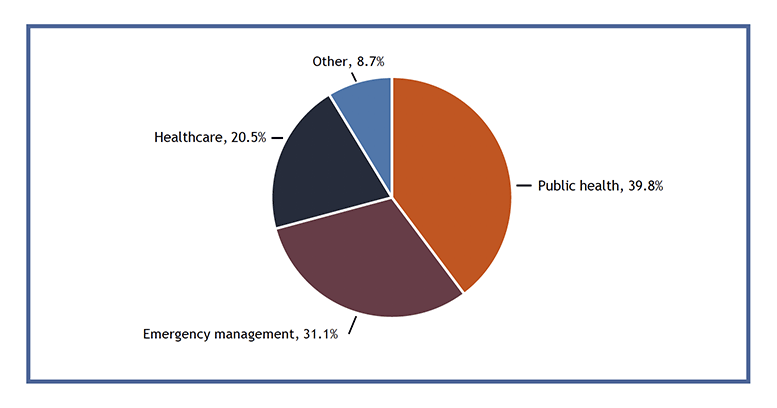Assessing Capacity Gaps in the Radiation Readiness Workforce
July 29, 2025
Radiation readiness is a critical piece of emergency preparedness. In the case of a radiological incident, public health plays an important role in keeping communities safe and ready. Public health, health care, and other sectors can build stronger emergency response capabilities when working together. One such coalition is the National Alliance for Radiation Readiness (NARR),which unites emergency management, health care, and public health to improve radiation readiness. The NARR works to increase capacity by connecting across sectors and levels of government.
ASTHO provides support to the NARR in several ways, such as providing resources to enhance emergency preparedness in the radiation readiness workforce. In early 2025, ASTHO performed a knowledge and capacity assessment of the radiation readiness workforce through funding support from CDC. This assessment aimed to understand the current status of knowledge and capacity of radiation readiness among professionals working in public health, health care, and emergency management.
Assessment Methods
ASTHO created this assessment with input from the NARR and several other knowledgeable experts. NARR and were asked to distribute this assessment to relevant groups and individual contacts on a volunteer basis according to their internal policies. ASTHO shared this assessment through various channels including relevant peer networks and newsletters. The assessment was open from February 3, 2025, through February 28, 2025.
Key Findings
ASTHO received 425 unique responses to the needs assessment. The majority of respondents identified as either public health (39.8%) or emergency management (31.1%) professionals, as shown in Figure 1.
The majority of respondents were well-experienced in radiation readiness. Most respondents indicated that they have either more than 10 years (38.4%, N=163) or six to 10 years (16.3%, N=69) of experience in radiation readiness. A majority (n=277, 65.2%) of respondents reported working at a governmental organization while others worked at non-governmental or non-profit organizations or associations (n=22, 5.2%), health care organizations (n=112, 26.4%), laboratories (n=7, 1.6%) or, identified with other entities (n=7, 1.6%). The majority of governmental respondents indicated they worked at either local (n=132, 49%) or state (n=119, 44%) government agencies [Figure 2]. The rest indicated they worked at the regional (n=10, 3.7%) or federal (n=8, 3%) level [Figure 2].
"We need better integration between public health and emergency management. We are one "system" that needs to come together more consistently and seamlessly. Both focus areas could leverage a lot of expertise. Also, there needs to be a greater focus on one public emergency response system, even though parties will be more or less involved in certain aspects."

![Figure 2 is a pie chart showing governmental organization or agency by structural level [N=271]](/globalassets/images/graphs-charts/astho-report-radiationreadinessworkforce-figure2-072925.png)
Respondents were asked to rate their individual level of knowledge in various areas of radiation readiness. Respondents most frequently rated themselves as experts in the following areas: emergency preparedness exercises (14%), training (12.8%), planning (10.7%), and decontamination (10.6%). Respondents were less likely to rate themselves as experts in the following areas: laboratory readiness (1.3%), long-term follow-up (2.2%), and long-term recovery (2.4%).
Respondents were also asked to describe the knowledge gaps in their field at large (public health, emergency management, or health care, respectively) regarding radiation readiness. Respondents most frequently mentioned a lack of training and practical experience (92 respondents), widespread lack of basic knowledge and misunderstanding of radiation itself (61 respondents), a lack of prioritization and leadership support (40 respondents), and issues around public health and emergency management coordination (38 respondents) among other concepts. This indicates there is a need for both training in specialized topics and general radiation readiness.
Respondents also reported on their organizations’ workforce capacity in various radiation readiness areas. Respondents most frequently reported having the workforce capacity to do internal coordination (n=234, 66.3%), public communications (n=230, 65.2%), and distribution of medical countermeasures (n=203, 57.5%). Respondents most frequently reported that they did not have the workforce capacity to respond to a nuclear detonation (n = 196, 55.4%), a radiological dispersal device/radiological exposure device incident (n = 150, 42.7%), or a nuclear power plant incident (n = 147, 41.5%). This suggests that there would be a significant need to surge staffing to respond adequately to a radiological incident.
Funding emerged as a significant barrier for preparedness, with inconsistent support impacting staffing, training, exercise planning, and access to resources and technology. To strengthen organizational capacity for radiation readiness, respondents most frequently emphasized the need for funding (47 respondents) that would support with hiring, training, acquiring equipment, and conducting exercises. Respondents also frequently mentioned the need for additional staffing (34 respondents), particularly for roles dedicated to radiological planning and emergency response, such as program managers and subject matter experts (16 respondents). Respondents emphasized that investment in radiation readiness funding is needed to strengthen workforce development, enhance subject matter expertise, and drive leadership support for radiation preparedness activities.
"Gaps include an aging workforce with insufficient numbers of radiation professionals coming up to replace them. Also, there is a lack of funding to train, plan, and practice - especially practice with partners from other organizations. Also, a bunch of organizations exist in silos and not working together."
Moving Forward
The results of this assessment will guide future NARR initiatives in advancing radiation readiness across sectors. These findings underscore the need for a coordinated and well-funded approach to radiation readiness, with emphasis on capacity building, continuous training, and interagency preparedness planning. The findings of this assessment highlight gaps in radiation readiness, including dedicated staffing, general training, and specialized subject matter expertise. The NARR stands ready to support radiation readiness professionals in filling these gaps through training, resource development, and collaboration.
Other Resources
- The National Alliance for Radiation Readiness (NARR): Reflections on Critical Conversations
- National Alliance for Radiation Readiness Radiation Training Modules for Public Health
- NARR Background Slides
- FEMA: Nuclear Detonation Response Guidance Planning for the First 72 Hours
- FEMA: Radiological Emergency Preparedness Program Manual